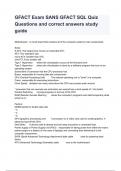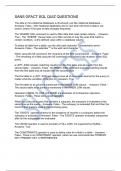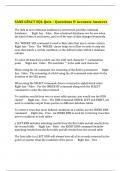Sans gfact sql - Study guides, Class notes & Summaries
Looking for the best study guides, study notes and summaries about Sans gfact sql? On this page you'll find 17 study documents about Sans gfact sql.
All 17 results
Sort by

-
SANS GFACT SQL QUIZ QUESTIONS AND ANSWERS
- Exam (elaborations) • 2 pages • 2024
- Available in package deal
-
 luzlinkuz
luzlinkuz
-
- $10.99
- + learn more
SANS GFACT SQL QUIZ QUESTIONS AND ANSWERS...
GFACT Exam SANS GFACT SQL Quiz Questions and correct answers study guide
SANS GFACT SQL QUIZ QUESTIONS
SANS GFACT SQL Quiz – Questions & Accurate Answers
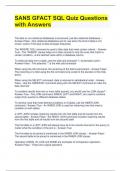
-
SANS GFACT SQL Quiz Questions with Answers
- Exam (elaborations) • 2 pages • 2024
-
Available in package deal
-
 Scholarsstudyguide
Scholarsstudyguide
-
- $12.99
- + learn more
SANS GFACT SQL Quiz Questions with Answers The data in non-relational databases is structured, just like relational databases. - Answer-False - Non-relational databases are for use when the kind of data is not known, and/or if the type of data changes frequently. The 'WHERE' SQL command is used to filter data that meet certain criteria. - Answer-True - The `WHERE` clause helps us to filter records to only the ones that match a certain condition, defined value within a database column T...
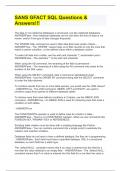
-
SANS GFACT SQL Questions & Answers!!!
- Exam (elaborations) • 2 pages • 2024
-
 shantelleG
shantelleG
-
- $8.99
- + learn more
The data in non-relational databases is structured, just like relational databases. - ANSWERFalse - Non-relational databases are for use when the kind of data is not known, and/or if the type of data changes frequently. The 'WHERE' SQL command is used to filter data that meet certain criteria. - ANSWERTrue - The `WHERE` clause helps us to filter records to only the ones that match a certain condition, defined value within a database column

-
SANS GFACT SQL Quiz Questions Latest Update 2024-2025 Actual Exam Questions and 100% Verified Correct Answers Guaranteed A+
- Exam (elaborations) • 2 pages • 2024
-
Available in package deal
-
 Tutordiligent
Tutordiligent
-
- $20.49
- + learn more
SANS GFACT SQL Quiz Questions Latest Update Actual Exam Questions and 100% Verified Correct Answers Guaranteed A+
SANS GFACT SQL Quiz Questions with correct Answers
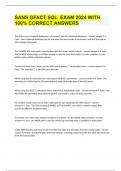
-
SANS GFACT SQL EXAM 2024 WITH 100% CORRECT ANSWERS
- Exam (elaborations) • 2 pages • 2024
-
 YANCHY
YANCHY
-
- $16.49
- + learn more
The data in non-relational databases is structured, just like relational databases. - correct answer False - Non-relational databases are for use when the kind of data is not known, and/or if the type of data changes frequently. The 'WHERE' SQL command is used to filter data that meet certain criteria. - correct answer True - The `WHERE` clause helps us to filter records to only the ones that match a certain condition, defined value within a database column To select all data from a tab...

-
SANS GFACT SQL Quiz Questions & Answers 100% Accurate!
- Exam (elaborations) • 2 pages • 2024
- Available in package deal
-
 papersmaster01
papersmaster01
-
- $14.99
- + learn more
The data in non-relational databases is structured, just like relational databases. - ANSWERSFalse - Non-relational databases are for use when the kind of data is not known, and/or if the type of data changes frequently. The 'WHERE' SQL command is used to filter data that meet certain criteria. - ANSWERSTrue - The `WHERE` clause helps us to filter records to only the ones that match a certain condition, defined value within a database column To retrieve rows that meet defined condit...

That summary you just bought made someone very happy. Also get paid weekly? Sell your study resources on Stuvia! Discover all about earning on Stuvia

